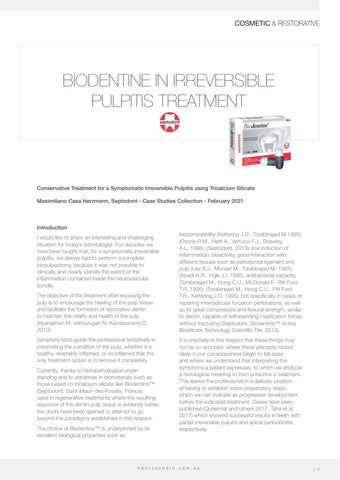COSMETIC & RESTORATIVE
BIODENTINE IN IRREVERSIBLE PULPITIS TREATMENT
Conservative Treatment for a Symptomatic Irreversible Pulpitis using Tricalcium Silicate Maximiliano Casa Herzmann, Septodont - Case Studies Collection - February 2021
Introduction I would like to share an interesting and challenging situation for today’s odontologist. For decades we have been taught that, for a symptomatic irreversible pulpitis, we always had to perform a complete biopulpectomy because it was not possible to clinically and clearly identify the extent of the inflammation contained inside the neurovascular bundle. The objective of the treatment after exposing the pulp is to encourage the healing of the pulp tissue and facilitate the formation of restorative dentin to maintain the vitality and health of the pulp (Abarajithan M, Velmurugan N, Kandaswamy D, 2010). Sensitivity tests guide the professional tentatively in interpreting the condition of the pulp, whether it is healthy, reversibly inflamed, or so inflamed that the only treatment option is to remove it completely. Currently, thanks to histopathological understanding and to advances in biomaterials such as those based on tricalcium silicate like Biodentine™ (Septodont, Saint-Maur- des-Fossés, France), used in regenerative treatments where the resulting response of the dentin-pulp tissue is evidently better, the doors have been opened to attempt to go beyond the paradigms established in this respect. The choice of Biodentine™ is underpinned by its excellent biological properties such as
biocompatibility (Kettering J.D., Torabinejad M.1995), (Osorio R.M., Hefti A., Vertucci F.J., Shawley A.L, 1998), (Septodont, 2013); low induction of inflammation, bioactivity, good interaction with different tissues such as periodontal ligament and pulp (Lee S.J., Monsef M., Torabinejad M, 1993), (Abedi H.R., Ingle J.I. 1995), antibacterial capacity, (Torabinejad M., Hong C.U., McDonald F., Pitt Ford T.R, 1995); (Torabinejad M., Hong C.U., Pitt Ford T.R., Kettering J.D, 1995), but specifically in cases of repairing interradicular furcation perforations, as well as its great compressive and flexural strength, similar to dentin, capable of withstanding mastication forces without fracturing (Septodont. Biodentine™ Active Biosilicate Technology Scientific File, 2013). It is precisely in this respect that these things may not be so accurate: where these precepts rooted deep in our consciousness begin to fall apart and where we understand that interpreting the symptoms a patient expresses, to which we attribute a histological meaning to then prescribe a treatment. This leaves the professional in a delicate position of having to establish some preparatory steps, which we can indicate as progressive development, before the indicated treatment. Cases have been published (Qudeimat and others 2017, Taha et al. 2017) which showed successful results in teeth with partial irreversible pulpitis and apical periodontitis, respectively.
h en r y sc h e i n .c o m .a u
2 9











